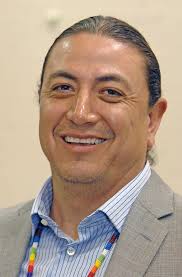Traditional
Traditional Leaders of the Hunkpapa Lakota
When describing leadership among the tribal nations, it is important to know that the traditional American Indian concept of leadership was quite different than that of the Euro-American concept of leadership.
Unlike the Euro-American concept of formal majority vote, American Indian leaders were chosen simply by the people who chose to follow them. For example, a leader of a traditional Indian encampment would be a leader only as long as the people agreed with his decisions. If he made a major error in judgment or began to make unfavorable decisions, the people would no longer listen to him. If some of the people still agreed with him, however, they might continue to recognize him as leader and might even have gone so far as to break away from that encampment to create their own little band.
Historically, treaty agreements and peace talks between the Indian people and the U.S. government were extremely difficult to coordinate because of this fact. Indian people did not consider it appropriate for one person to make decisions for everyone else. This frustrated government officials, who were hard-pressed to find an “official spokesman” for an entire tribe.
It is important to understand this concept of voluntary leadership among Indian people since some of the historical figures who were considered “leaders” were not considered leaders by all tribal members. Even today, there is debate over who was a true leader among the Lakota and Dakota people.
There are, however, many prominent figures among the ancestors of the Standing Rock Nation.
SITTING BULL (Born 1834—Died 1890)
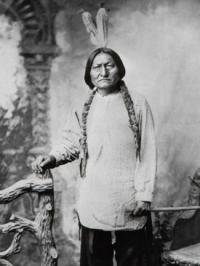
Perhaps the most famous leader among the Hunkpapa and, indeed, throughout the world, is Sitting Bull. Sitting Bull was born on the Grand River in 1834. As a youth, historical accounts assert that Sitting Bull was already a deep thinker and a strong warrior.
Sitting Bull, Tatantanka Iyotake, was known best for his part in the Battle of the Little Bighorn. Before the battle, Sitting Bull had a vision of soldiers falling into camp. This vision reinforced the belief in the strength of Sitting Bull’s medicine. Sitting Bull was commended, by Indian and non-Indians alike, for his generosity and his concern for people. lit his later years, when he traveled with the Buffalo Bill Wild West Show, Sitting Bull was often seen giving money to the street urchins of the cities he visited. He once commented that he could not understand how there could be so much poverty in the midst of such wealth.
Sitting Bull strongly protested against any cessions of Indian land and opposed the confinement to reservations. In fact, after the Battle of the Little Bighorn, Sitting Bull fled to Canada and remained there with his band of followers until 1881. After he returned to the reservation, he remained an outspoken advocate for his people until his murder in 1890.
RAIN IN THE FACE (Born 1835—Died 1905)
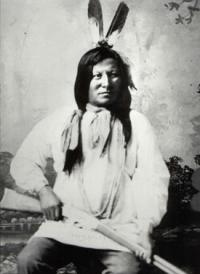
Chief Rain-in-the-Face was a brave warrior and stood firmly in preventing the killing of game and buffalo of the Lakota. His warriors once attacked railroad survey crews. Captain Yates, Tom Custer, and 100 cavalrymen arrested Rain-in-the-Face for killing two trespassers on Lakota land. He later escaped for the guardhouse at Fort Lincoln. He was a key leader who fought Custer in the Battle of the Little Bighorn on June 25, 1876. On a buffalo hunt in 1877, a gun he was carrying accidently discharged hitting him in the knee and crippling him. True and loyal to the Lakota people, Rain-in-the-Face died at Little Eagle, on the Grand River, September 12, 1905. (Cross H. 1927, p.57)
GALL (Born 1840—Died 1894)
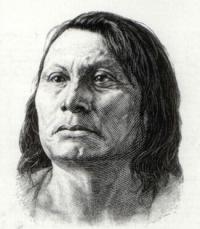
Renowned Chief of the Hunkpapa Sioux, Gall was born near the Moreau River, South Dakota in 1840. As a young man he was recognized as a warrior. He gained chieftaincy by his own daring exploits and superiority in statesmanship and oratory, and became one of Sitting Bull’s most trusted counselors. Although not actively engaged in the Battle of the Little Bighorn, June 25, 1876, he was in command of one wing of the Lakota, and from a distance ingeniously outlined the movements that defeated General Custer and his command. He fled to Canada, but on January 1, 1881, voluntarily surrendered to Major Ilges at Poplar River Camp, Montana. He travelled America and Europe with Buffalo Bill. He died at Oak Cree, South Dakota, December 5, 1894, and was buried with military honors. (Cross H. 1927, p.24)
JOHN GRASS (Born 1839—Died 1918)
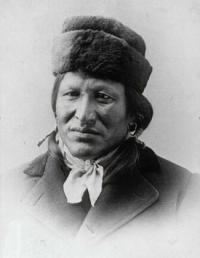
Chief of the Sihasapa Sioux. His Indian name was Matowatakpe. As an orator he had no equal as he understood and spoke all the tribal languages. Grass was a proficient interpreter of sign language which was practically universal with all tribes on the plains. He was principal advisor to Sitting Bull and has been given credit for assembling the 7,000 warriors which fought and defeated General Custer. John Grass was born in 1839 and was only 37 years of age at the time of the Custer battle. He died at Fort Yates, North Dakota, May 10, 1918, at the age of 79 years. (Cross H. 1927, p.32)
TWO BEARS
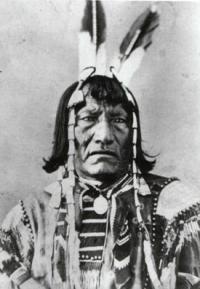
Two Bears (Mato Nopa) was one of the prominent chiefs of the Upper Yanktonais. The Yanktonais hunting territory ranged from the eastern Dakota Territory to the Missouri River. Around 1865, Tow Bear’s band camped near Fort Rice. Two Bears served the council at Fort Rice at the July 1867 treaty commission meeting at Fort Rice with the Lakota. At the council at Fort Rice, on July 2, 1868, Chief Two Bears voiced his objections to the reservation proposal:
“Now I will tell you one thing that I don’t like; you are going to put all the tribes together and I do not approve of it. I speak for my own band; our country is on the other side of the river—we are Yanktonais...The trouble was begun by the whites rushing into our country...There is one thing that I must tell you; though I want to make peace, yet I don’t want to sell my land to the whites. It is the whites who will break the treaty, not us. I don’t give permission to any white man to chop wood and get hay in our country.”
By 1879, the Burnt Lodge, Lower Yanktonais settled 40 miles above the Grand River Agency on the east side of the Missouri River. Two Bears’s band included 55 lodges (families).1
THUNDERHAWK (Born 1834—Died ?)
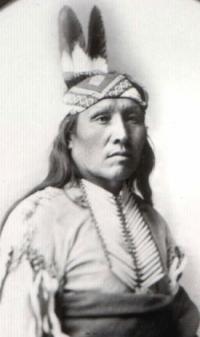
Though little is written about Chief Thunderhawk, it is known that as a young man he was a companion of Sitting Bull, and a warrior of prominence. Since the Hunkpapa were a small band, Thunderhawk figured importantly in Hunkpapa and Lakota affairs. He was Chief of his band, a position which he retained all his life. His band followed the buffalo. During the 1870s, Thunderhawk was a dominant leader of the reservation Hunkpapa people at the Grand River Agency. After allotment, his band moved to 20 miles below the agency where his band constituted 28 lodges. He is credited, along with Mrs. Galpin, with saving the life of Father DeSmet. He, along with several other Hunkpapa, represented the Hunkpapa at the Sioux Indian delegation in Washington, D.C. in October, 1888.2
RUNNING ANTELOPE (Born 1821—Died 1897)
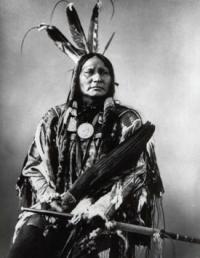
Running Antelope, in his earlier years, was closely allied with Sitting Bull, who was eleven years his junior. Running Antelope, a band chief, was prominent among the Lakota. In 1851, Running Antelope was elected one of four “shirt wearers” of the Hunkpapa. A shirt wearer served to intercede between the council and the headmen and akicita who carried out tribal policy and decisions. He was a brave warrior and accomplished diplomat. Under the influence of James McLaughlin, he became a dominant leader of the reservation Hunkpapa people at the Grand River Agency. After the allotment period, Running Antelope established a settlement of about sixty families in the Grand River Valley and opened a store. In his later years, he regretted signing the 1868 Fort Laramie Treaty and longed for the time when the Lakota were free, and realigned with Sitting Bull. It was often said that Running Antelope was the greatest orator of the Sioux Nation.3
Contemporary
Most of North Dakota’s Tribal Nations had not accepted the 1934 Wheeler-Howard Act, also known as the Indian Reorganization Act (IRA) as a form of tribal governance mandated by the legislation. However, as early as the middle 1940s, the Standing Rock Nation operated under the leadership of a tribal business council. A Tribal Constitution was adopted in 1959.
The following is a partial* list of those chairpersons who were prominent from the period of the middle 1940s to the present.
*List of tribal chairperson was gleaned form the memories of the Lakota/Dakota people at Standing Rock. Most of the information gathered was reconstructed from selected news articles from the Bismarck Tribune, between 1934 and 1991.
- **Jack Iron Road, District of Porcupine
- Martin Medicine, District of Wakpala
- Richard Ramsey, District of Cannonball
- Eugene Young Hawk, District of Bullhead
- John Gates Sr., District of Fort Yates, 1947–1948
- Josephine Kelly, District of Fort Yates, 1948–1951
- David S. Blackoop, District of Fort Yates, 1951–1953
- Whitney J. Agard, District of Fort Yates, 1953–1955
- J. Dan Howard, District of Bullhead, 1955–1956
- Edward Loon, District of Fort Yates
- Marguerite Fiddler, District of Wakpala
- Theodore Jamerson, District of Porcupine, 1958–1959
- James McLean, District of Wakpala, 1959–1960
- Clayton Brown Otter, District of Bullhead, 1960–1961
- Aljoe Agard, District of Fort Yates, 1961–1969
- (Agard served as interim chairman, replacing Clayton Brown Otter.)
- Douglas Skye, District of Porcupine, 1969–1970
- Melvin White Eagle, District of Cannonball, 1970–1971, 1973–1975
- Pat McLaughlin, District of Wakpala, 1975–1979
- Frank A. Lawrence, District of Bear Soldier, 1979–1981
- Pat McLaughlin, District of Wakpala, 1981–1983
- Charles W. Murphy, District of Porcupine, 1983–1993
- Jesse “Jay” Taken Alive, District of Bear Soldier, 1993–1997
- Charles W. Murphy, District of Porcupine, 1997–2005
- Ron His Horse Is Thunder, District of _____, 2005–2009
- Charles W. Murphy, District of Porcupine, 2009–2013
- Dave Archambault II, District of ______, 2013 -- Present
** List Not Validated: Conversation with Earl Silk, BIA Tribal Operations, presently Contracting Administrator for the Standing Rock Sioux Agency. April 12, 1995.4
JOHN GATES 1947–1948
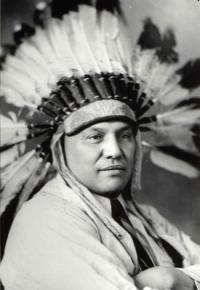
John Gates served as Chairman of the Standing Rock Sioux Tribe during the period following the Indian Reorganization Act. In 1944, Gates won three times the North Dakota state light heavyweight boxing title. Prior to serving in the military, Gates represented North Dakota at the Minneapolis Golden Gloves tournament. In 1945, John Gates, at the age of 15 and a Marine Corporal, received the Bronze Star for aiding wounded comrades on the beach of Sai Pan on D-Day. Gates was wounded and spent two years in the Pacific and Guadalcanal.
During his tenure as tribal chairperson, he, along with Willis Mountain, Secretary for the Tribe met with John Collier, Indian Bureau Commissioner, to relate the severity of conditions on the reservation which had been bad for several years. They related that $270,000 allocated for the tribe had been spent by the Indian agent in four months on equipment and administration. In later years, he worked for the candidacy of John Vucuvevich, a Rapid City banker and served as a member of the South Dakota Indian Affairs Commission.5
JOSEPHINE GATES KELLY 1948–1951
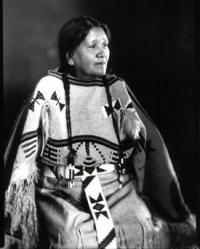
Josephine Gates Kelly was born in 1888 or 1889. She became chairwoman of the Standing Rock Business Council in 1948 serving consecutive one-year terms until 1951. Her father was Frank Gates and her mother was Nellie Two Bears, daughter of chief Two Bears. She was raised at Standing Rock until the age of 12. She attended Carlisle Indian School from 1902 to 1909. She was the first woman from Standing Rock to finish at Carlisle. She was elected to the tribal council in 1940 and elected Chairperson to yearly terms in 1946–1947–1948. In 1940, she hitchhiked to Washington D.C. with another woman to protest the Indian Reorganization Act.
Kelly and F. David Blackhoop, Secretary for the Tribe, traveled to Washington D.C. to oppose the consolidation of the Standing Rock and Cheyenne River Agencies, proposed by the Indian Bureau in 1951.6 She spoke before the U.S. Senate Appropriations Committee in Washington, D.C. on behalf of U.S. Women’s Day with the coming of the Freedom Train. She died October 23, 1976.7
F. DAVID BLACKHOOP 1951–1953
F. David Blackhoop, from the Fort Yates district, succeeded Josephine Kelly as tribal chairperson.8 In 1949, Blackhoop, forced the removal of James E. Curry, tribal attorney who ill advised the Standing Rock Sioux Tribe in the settlement of the Oahe Reservoir negotiations. Blackhoop served as the chairman of the negotiating committee of fifteen, which negotiated the $1.6 million for the 54,000 acres in the Missouri River Basin flooded by the Oahe Reservoir.
Blackhoop was instrumental in framing the Standing Rock Sioux Tribal Constitution, adopted in 1959. He later became one of two tribal judges appointed in 1962.9
WHITNEY J. AGARD 1953–1955 (unconfirmed)
J. DAN HOWARD 1955–1956
J. Dan Howard served on the Standing Rock Tribal Council during the time period when the Sioux Nations were seeking restitution for the taking of the Black Hills. The Black Hills claim had been brought twice before the newly established Indian Claims Commission (1946), and been rejected. Two tribes, the Standing Rock Sioux and the Rosebud Sioux, traveled to Washington, D.C. on November 30, 1955 to meet with Ralph Case, attorney who initially brought forward the initial Black Hills claim in September of 1911, litigated the claim for 32 years. It was with the intent of asking for Case’s dismissal from the claim, that J. Dan Howard, Chairperson, James McLean, and Isaac Hawk, of the Standing Rock Tribal Council, met to register the Tribe’s opposition to the Indian Claims Commission decision, and to ask the Court of Claims to retain jurisdiction.10
THEODORE JAMERSON 1958–1959
Theodore Jamerson was born June 18, 1919, in Fort Yates, to James and Susan (Twiggs) Jamerson. He attended school in Fort Yates and Mayville State University. After serving in the Navy in World War II and Korea, Jamerson became chairman of the Standing Rock Tribal Council in 1958. He also served as councilman from the Fort Yates district. Jamerson organized the United Tribes Development Corporation of North Dakota, and was prime organizer of United Tribes Educational Technical Center (later to become United Tribes Technical College). He also served for a time as United Tribes Educational Technical Center’s director. In 1971, he joined the Bureau of Indian Affairs as a special assistant to the area director. In 1970, he told a U.S. House subcommittee in Washington, D.C., that Indian tribes and reservations should be allowed to deal directly with the federal government in manpower development programs. A consummate and energetic man, Jamerson died at the age of 54 on June 29, 1973 in Fort Yates.11
JAMES MCLEAN 1959–1960
CLAYTON BROWN OTTER 1960–1961
ALJOE AGARD 1961–1969
Alfred Joseph Agard, whose Lakota name is “S’unka Hakin,” “One Who Stalks Wearing Wolf Skin” was born at Black Horse, South Dakota on June 12, 1928 to James and Isabelle (Shoestring) Agard. His grandfather was Moses Old Bull. His parents died when he was very young, and he was sent to the Fort Yates boarding school at a young age. He enlisted in the U.S. Army on July 17, 1946, and served two tours of duty, the second during the Korean War from 1951–1953. He received the Korean Service Medal, the Bronze Star, and the U.S. Service Medal.
Active in Tribal Affairs, “Aljoe,” as he was known, supported the authorization of the Indian Child Welfare Act in 1978 and was instrumental in securing an Indian reservation housing provision to the Public Housing Act. He became tribal chairman in January of 1961, a position which he held for nine years. During his chairmanship he was active in securing appropriations for the Tribally Controlled Community Colleges Act, was co-founder of United Sioux Tribes of South Dakota, and a delegate to the Black Hills Steering Committee, which supported legislation to recover the Black Hills. He was active in the National Congress of American Indians.
From 1984 to 1992, he was instrumental in the Joint Tribal Action Committee (JTAC) to seek compensation for lands lost in the construction of the Oahe Reservoir, which resulted in passage of P.L. 102-575, the Standing Rock Economic Recovery Fund, providing $90.6 million in additional compensation. He remained actively involved in his community of Fort Yates as a community representative on the gaming commission, local district planning commission, and treasurer for the elderly resident organization. Throughout his 40 years of tribal leadership, he was a staunch believer in the sovereignty and jurisdiction of the Standing Rock Nation, a position which he reinforced at every opportunity. A modest, quiet, kind, and committed leader, his dream was to help the underprivileged in captivity of the welfare system to achieve human dignity. He served on the Standing Rock Sioux Tribal Council until is death in 1994.
DOUGLAS SKYE April 1969–October 1970
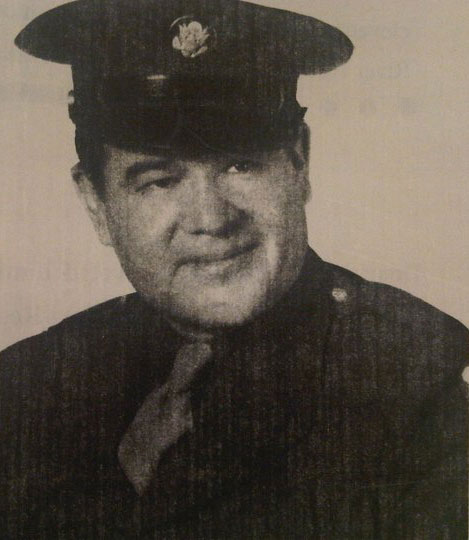
Douglas Skye, 65 year-old retired BIA land officer, was elected Standing Rock Tribal chairperson in the spring of 1969. Skye retired from the BIA after 36 years of service. Douglas Skye was born and raised in the Porcupine District near Shields, where his father was a rancher. He attended rural schools, Flandreau, South Dakota Indian School, and Haskell Institute at Lawrence, Kansas. His first job was as a clerk-stenographer in the North Dakota attorney general’s office in the 1930s. He began working for the BIA in 1935 and was made property officer in 1956. He was committed to tighten up the structure of the tribal council and its committees, and for making the tribe more responsive to the people. Jobs were on top of his list and he deplored the breakdown of Indian society. “Our people had a pretty good life in the first part of the century. It was simple but there was dignity in our living. A man looked at this quarter section, his 20 head of cattle, and his horses, big garden, and said, “that’s mine.” The drought and depression of the 1930s, the taking of the rich bottomlands for Lake Oahe, and increased use of alcohol in the 1950s contributed to the problems. Skye, a respected Indian leader, was the first to help organize the Standing Rock Commission on Alcoholism and served as a member of the National Indian Commission on Alcoholism. 13 He died on October 9, 1970, while serving as tribal Chairman of the tribe.
MELVIN WHITE EAGLE 1970–1971, 1973–1975
Melvin White Eagle was born at Cannonball, North Dakota on September 27, 1926. His education began at Pierre Indian School. He joined the Army and served in World War II and two combat tours in Korea, during which he completed high school. Married in 1953, he and his wife, Blanche, moved to Mountain View, California. Returning home in 1962, Melvin worked for the Cannonball School, and later served on the School Board. From 1965–1970 he served on the Standing Rock Tribal Council as tribal secretary and vice-chairperson. In 1970 he was elected as Chairman of the Tribe. During his leadership, Melvin continued the 30 Master Plan for Economic Development, initiated under the Skye administration. He was reelected for a second term from 1973–1975. During his administration the Tribe received a $2.6 million contract to construct modular homes on the reservation. The homes were constructed by a locally developed enterprise, Standing Rock Development Corporation. The tribe also received $3.5 million to build the Douglas Skye Retirement Complex for the elderly. Melvin served on the Tribal Council from 1980–1984. From 1970 to the present Melvin commuted to Bismarck, North Dakota where he was a staff member of United Tribes Technical College. During this time he served as Chairman of the Board for Theodore Jamerson Elementary School, and the Chairman of the Board of Directors of UTETC. He retired from United Tribes on June 9, 1995, and died on March 13, 1999.
PAT McLAUGHLIN 1975–1979, 1981–1983
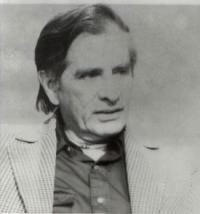
Pat McLaughlin served his first term as tribal chairperson in 1975. During that time elections for district councilmen were held on odd number years. In July of 1977, McLaughlin brought together the Governor of North Dakota, Art Link, and Richard Kneip, Governor of South Dakota to iron out problems of inequality of the welfare systems. McLaughlin also advocated for the consolidation of tribal lands on the reservation. In December of 1977, the Tribe went on record opposing a bill which would limit tribal jurisdiction and water rights. During his administrations, ground-breaking ceremonies were held for the $7.2 million Standing Rock High School. The existing school had been built in 1942 and enlarged in 1956. By December of 1977, the Tribe began dialogue with the U.S. Forest Service to explore the ownership and recision to the tribe of 34,342 acres of national grasslands on the western portion of the reservation to the tribe. In September of 1981, Pat McLaughlin returned to office for a third tern. Voters approved a $1.5 million federal land claims. During his third term, the Douglas Skye Retirement Complex was sold to the Tribal Housing Authority and funds were provided by HUD to renovate the facility. Pat McLaughlin did not seek reelection in 1983. McLaughlin has served intermittently on the tribal council, serving as vice-chairman in 1995.15 He died on December 29, 2002, in Bismarck.
FRANK LAWRENCE 1979–1981
Frank Lawrence, a resident of McLaughlin, South Dakota, was born December 23, 1941. A graduate of Fort Yates Community High School, he served in the Air Force from 1965 to 1969. He graduated from Black Hills State College, Spearfish, South Dakota 1973. In October of 1979, Lawrence was sworn in as Tribal chairperson of the Standing Rock Sioux Tribe succeeding Pat McLaughlin who had held the post for four years. It was Lawrence’s first elected office. Lawrence served as assistant general manager of Standing Rock Housing Corporation, and Executive Director of United Sioux Tribes Development Corporation. He also served as Indian Education Director for United Sioux Tribes of South Dakota. He was instrumental in forming the South Dakota Indian Education Association. He campaigned for better management of the tribe, advocating for greater accountability and control of the tribes financial situation. He died on April 16. 1989.16
JESSE “JAY” TAKEN ALIVE 1993–1997
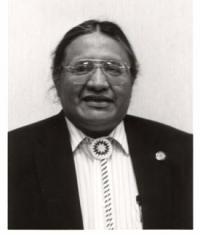
Jesse “Jay” Taken Alive was born in Fort Yates on May 1, 1955. His parents are the late Pete Taken Alive and Imogene Taken Alive. He received his education at the BIA elementary school and Fort Yates Public High School. He is married and has five children. A fluent Lakota Speaker, Jesse is a descendent of Rain-in-the-Face. During his early years, Jesse Taken Alive worked with Standing Rock Community College, the BIA elementary school, and chemical prevention program. In 1991, at the age of 38, he was elected to the Tribal Council. In 1993, he became Tribal Chairman. A believer in leadership by example, one of his first actions as tribal chairperson was to hold an ethics retreat for the Tribal Council. During his administration, the Tribe saw the completion of the Prairie Knights Casino and Lodge located on the reservation; establishment of a Tribal Veterans Administration Office, elderly protection team office, creation of a tribal department of education, conversion of the BIA school to a tribal grant school, and revival and restoration of the Gall Inn in Mobridge, South Dakota, nearing the renovation stage as a regional youth treatment center. During this time period, the tribe received notification it would share in $906 million in compensation for lands lost as a result of the Oahe Reservoir. The Standing Rock Tribal Nation continues planning for the construction of a bridge over the Missouri River, construction of a new tribal administration building, and four community buildings on the reservation, support for a local radio station planned for implementation in 1995, and anticipates the establishment of a branch bank to be located on the reservation.18
RON HIS HORSE IS THUNDER 2005–2009
Ron His Horse Is Thunder is a member of the Hunkpapa-Lakota Oyate and currently serves as the Tribal Chairman of the Standing Rock Sioux Tribe. In this capacity, he also is the Chairman of the Great Plains Tribal Chairman’s Association. In 1988 he received his Juris Doctorate from the University of South Dakota School of Law. In 1985, he received a Bachelor of Science degree from Black Hills State University. His Horse Is Thunder began his career by serving in several professional capacities, e.g., as an attorney, director, and grants evaluator on the Rosebud and Standing Rock Sioux reservations.
From 1991-1993, His Horse Is Thunder served as president of Standing Rock College, where he was responsible for the overall college operations. He took two years off as president of Standing Rock College and headed the American Indian College Fund based in New York, New York, where he served as the president from 1993-1995. In 1995, he accepted the position of president at Little Hoop Community College in Fort Totten, North Dakota. Returning to the presidency of Sitting Bull College (formally Standing Rock College) in 1996, His Horse is Thunder served in this capacity until his election as Tribal Chairman in 2005.
His Horse Is Thunder has served as a commissioner for the Higher Learning Commission for the North Central Accreditation for Schools and Colleges. He also served on the boards of the American Indian Higher Education Consortium and North Dakota Tribal College Association. In 2002, President George W. Bush appointed him as Chairman of the President's Board of Advisors on Tribal Colleges and Universities of which he continues to serve today. His Horse Is Thunder is married to Deborah Wetsit-His Horse Is Thunder.19 His Horse Is Thunder ran for re-election as tribal chair in 2009 but was defeated by Charles Murphy.
CHARLES MURPHY 1983–1993, 1997–2005, 2009–2013
In September 1983 Charles Murphy was elected chairman of the Standing Rock Sioux Tribe. Murphy served four consecutive terms in office from 1983 to 1991. During his term in office, Murphy testified before Congress on the social and economic impact of the Oahe Reservoir on Standing Rock tribal lands. The Tribe, under his leadership, developed a comprehensive Substance Abuse Treatment Center at Chief Gall Inn, near Mobridge, South Dakota; saw the completion of an irrigation facility for tribal farm; and planned a tribal irrigation system under the Garrison Reformulation Act. The Tribe initiated construction of a new rural water system for the reservation. Murphy advocated for a higher education fund for Standing Rock Community College. Murphy believed in the principle that the tribe should solve its own problems and maintain the culture and language of the people. In January of 1991, Murphy was appointed by Secretary of Interior, Manuel Lujan, a member of the federal Task Force for the reorganization of the Bureau of Indian Affairs. In April of 1991, Congress drafted a bill to provide $91 million to North Dakota Tribes for payment of land taken by the Garrison Dam Project.”17 Charles Murphy did not seek reelection in 1993. He ran again in 1997, was elected and ran for reelection in 2001 and served until 2005. Charles Murphy was again elected tribal chair in 2009.
DAVE ARCHAMBAULT II, 2013-Present
